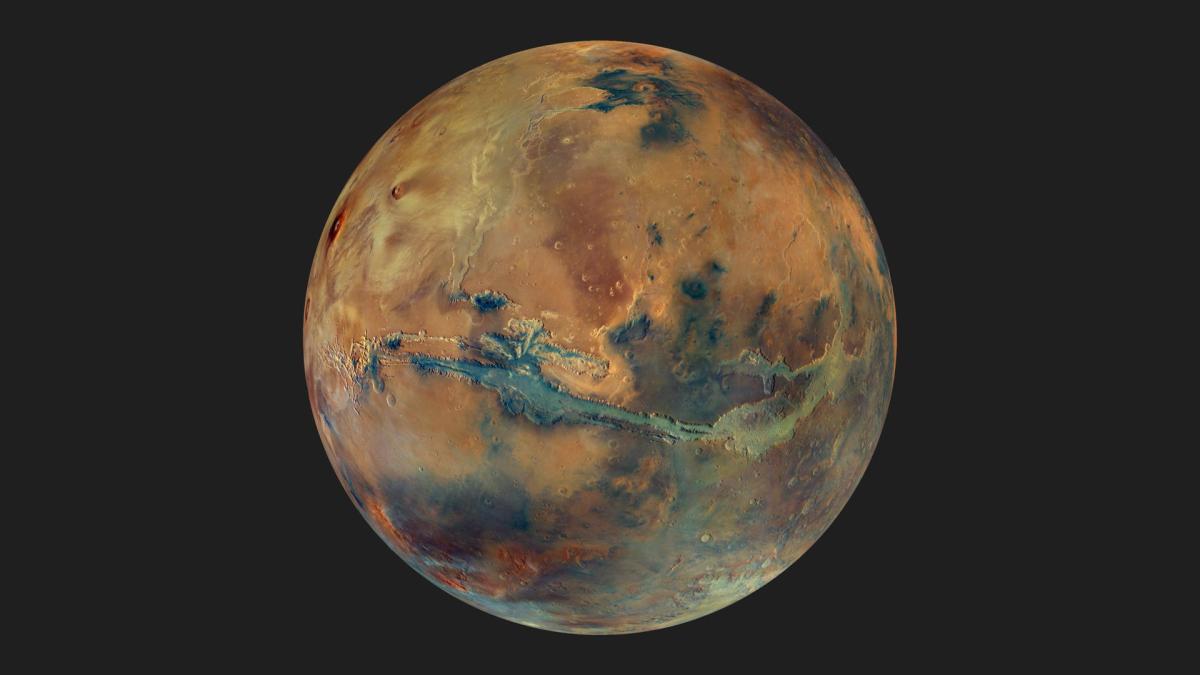A new image of a contemplation of Mars, “as never before” and in unprecedented color, commemorates the 20th anniversary of the European Space Agency’s (ESA) Mars Express mission orbiting the Red Planet. A test of resistance, because the forecast two years are already two decades.
ESA also plans to present today, for one hour on its YouTube channel, images of the planet, One every 50 seconds, live broadcast from the Mars rover’s video surveillance camera.
The new image released today is a mosaic of images that reveal the planet’s color and composition in “amazing detail,” made using data from the HRSC Camera.
In addition to their beauty, the mosaics provide fascinating information about the formation of Mars, revealing the diversity and Unprecedented color detailing on its surfaceEuropean Space Agency highlights.
Mars is known for its reddish color caused by high levels of oxidized iron, but the new image reveals large parts of the planet that appear somewhat dark and bluish in color, due to black-gray basalt sands of volcanic origin, Which form wide layers of dark sand.
Hydro-weathered materials tend to be lighter, the most common being clay and sulfate minerals, which appear particularly bright in such colorful compounds.
The presence of these minerals indicates that liquid water has been present on Mars for a long time, which has eroded and changed rocks over time to form large mud deposits.
The sulfate minerals are visible, though they are covered in a thin layer of dark sand, however Their impressive color contrasts can be appreciated upon close examination. ESA explains.
HRSC usually images the surface of Mars from about 300 kilometers away and the resulting images cover regions around 50 kilometers in diameter, but this time a slightly different approach was used to get a broader view.
This camera is just one of the tools on Mars Express, The mission launched today 20 years ago to MarsDestiny, which arrived on December 25, 2003.
The probe was to serve, in orbit around Mars, for one Martian year (687 Earth days) to study its geology, climate and atmosphere, and to provide valuable data on its history and potential to support life.
Its name Mars Express is no coincidence, as it was built and launched in record time and at a much lower cost than previous similar missions. But after two decades it “exceeded all expectations”acknowledges the European Space Agency, which expects it to remain in service, at least until the end of 2026.
Two decades translates to 1.1 billion kilometers traveled around Mars in more than 24,000 orbits, during which it has taken “stunning images of the Martian surface and its changing weather patterns, revealing diverse landscapes, from mighty volcanoes to deep valleys and ancient river beds.”
And the various instruments carried by the probe played a “major role” in revealing the water ice above and hidden under the surface of the planet, and revealing the water ice in the polar caps. The results have far-reaching implications.
The probe has also encountered problems over the years, which have been resolved by experts, from mishaps with solar panel wires, to collective memory problems causing long-term memory storage capacity loss.

“Proud web fanatic. Subtly charming twitter geek. Reader. Internet trailblazer. Music buff.”

:quality(85)/cloudfront-us-east-1.images.arcpublishing.com/infobae/TEQF6EONZRFGLLLDIDD4L2O4EE.jpg)

:quality(75)/cloudfront-us-east-1.images.arcpublishing.com/elcomercio/XU32LRAEZFDDPNVHLFU3CKVBYY.jpg)



More Stories
How to create 3D videos with my iPhone, it will be very useful even for your business
NASA discovers an anomaly in the Earth’s magnetic field that could have serious consequences for humans
Can the Earth be divided into two parts?